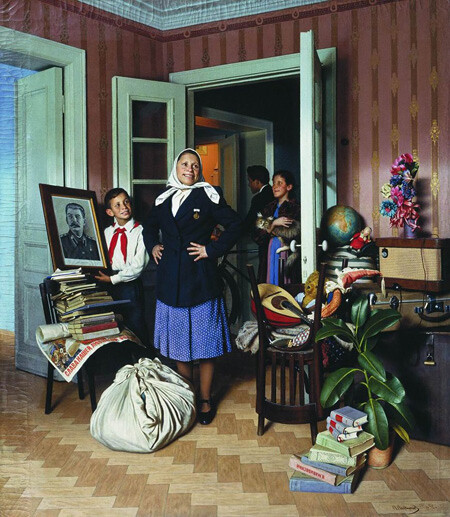Last year, I was taking a taxi into Kyiv’s downtown from Borispol Airport. About midway through the trip, I noticed a large black jeep coming straight towards my taxi on the same side of the road. It was not that it was traveling fast—no, it was more likely driving quite slowly. But it was going in the opposite direction on our side of the highway, which is divided by a high wall stretching almost the entire way from Kyiv to the airport. It was not entirely clear how this rudderless Flying Dutchman had gotten there.
“It’s goodfellas from Donetsk,” said the driver as he dodged the jeep.
This had been my only association with Donetsk prior to my arrival in this lovely city.
Donetsk is graced by rather broad, green boulevards and vast expanses in which one senses something elusively Soviet. In the city’s buildings, this Sovietness is far less elusive: it seemed to me that they had been built mainly in the fifties, and some of them feature elegant, sleek-bodied columns, that secondary sexual characteristic of an administrative branch with cultural ambitions. However, there is also something mirror-like in the city à la Dubai—a characteristic of an administrative branch with financial ambitions.
The secret of the Donetsk cityscape’s elusive Sovietness was later revealed to me by artist Sergey Bratkov, who brought to my attention that there is very little advertising on the streets of this city, and no street kiosks whatsoever. The local authorities had decided that this was how they wanted it. Donetsk, by the way, is no mere city, but the hometown of Ukraine’s current president.
In the evening, we decided to walk to the restaurant. My companions, who have some experience living in Donetsk, stopped at the crosswalk when the light turned red, although there were no cars to be seen on the horizon. When they noticed my look of amazement, they confessed they were afraid. When the lights of something broad-browed like a bison loomed somewhere in the distance, it became clear what they were afraid of. A black jeep raced by like a bullet, the desolate Sunday evening’s smooth surface closing again in its wake.
On early Sunday evenings, the residents of Donetsk stay at home in the European manner and get ready for the workweek ahead. This was apparent when we arrived at the restaurant. There was almost no one there, and as we soon found out, almost nothing to eat. Lyubov Mikhailova, after being told that several items on the menu were unavailable, asked for buckwheat kasha, a simple porridge and the most basic staple food imaginable. When it was brought to her, it turned out that it was a leftover from the previous day, if not the day before. Lyuba refused to eat it. The waitress apologized and said that the kitchen staff had already gone home.
Lyuba Mikhailova is the person responsible for my coming to Donetsk. As far as I know, Lyuba Mikhailova owns the entire petroleum coke chemical industry in Ukraine and is probably a millionaire, although I don’t know this for sure. She is not related to the Kharkiv artist Boris Mikhailov or his wife Vita, whose maiden name is also Mikhailova. Lyuba Mikhailova is the daughter of Ivan Mikhailov. Ivan Mikhailov was director of a factory that produced insulation, and by an amazing coincidence of the sort so common in the fairytale-like reality of the former Soviet Union, his daughter became the co-owner of the factory (along with numerous other assets). The factory has just been closed, and Lyuba Mikhailova is now turning it into a “platform for cultural initiatives.”
Ivan Mikhailov is quite upset by this turn of events. It is something incomprehensible to him that his factory, which had always fulfilled its production quotas for mineral wool, must now for some reason be turned into a museum, when it could just as well have gone on fulfilling quotas. At the opening of ISOLYATZIA, people consoled him by telling him that the factory’s new life was not a revocation of the past, but its continuation in a new form, because culture and contemporary art are in fact the new guise of industrial production. The head of the city’s Budyonny District went so far as to say that the advent of art at the factory was akin to Christ driving the moneychangers out of the Temple.
True, this sounded like a Gogolesque mix-up, for it was the emergence of the market—that is, the moneychangers—that actually brought about the factory’s demise. But this is essentially what lots of people think: work is hell, but culture is a temple. Where do people go on Sundays? To church. Well, they can also go to a contemporary art show.
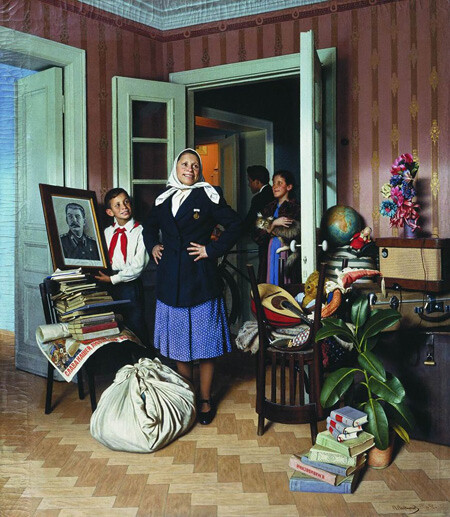

The director of the new art institution is Anastasia Butsko, a German journalist and a friend of mine. She is a very positive person: she has the ability to pronounce the phrase “I’m new to Donetsk” utterly naturally (something I myself could not manage), and I am absolutely certain that everything will work out for her in her new job as well. The more so because it is very much part of the zeitgeist to fill the void left by a closed production facility with culture. This idea is something that people immediately understand: cultural leisure comes to a site where excruciating physical labor once took place, and besides, this leisure comes with the cachet of big money attached (the first thing everyone knows about contemporary art is that it is expensive). Nastya Butsko, who has lived in Germany for a long time, knows of course that contemporary art there has a completely different cachet—that of serving society (whether this is deserved or not is another matter). But she also knows that in the post-Soviet world the general public does not really appreciate it when they are served anything social and it does not like anything connected with public life, preferring private life instead. Maybe it was always this way. I realized this when I saw Alexander Laktionov’s magnificent painting Moving to a New Apartment (1952), which I had only seen in reproductions before, at the Donetsk Art Museum. This anthem to insatiable Soviet consumerism is so grotesque that it seems like a specimen of Pop Art. This painting should be turned into an advertisement for a real estate agency, but portraits of war veterans line the streets of Donetsk instead of billboards.
I was driven around the city by another amiable, modest, and solicitous young woman named Yulya. To my surprise, Yulya turned out to be the director of a factory in Horlivka. She was just as solicitous when she spoke about her own factory, and her account was filled with sighs (there are problems there). Looking over her shoulder, she also told me in a whisper about the kópanki. Kópanki are illegal private coal mines located in the backyards of houses. They are practically holes in the ground, and illegal aliens, including women and children, break their backs inside these holes; as often as not they die there as well. When they die, cement is poured over them right where they lie. Everyone has heard about this, but few people have seen it or wish to see it. Actually, even in the legal private mines (there are no longer any publicly owned mines), coal is obtained using artisanal, open-pit methods.
***
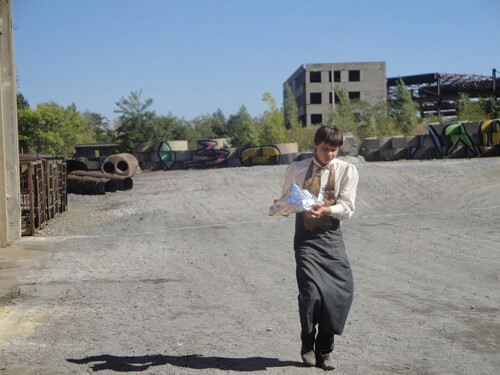

I had come to Donetsk primarily for a conference where we were supposed to talk about “converting the values of the past.” Because of a late flight, I missed the opening of the conference; when I walked in, the second panelist, an architect from Paris, was speaking. She had already finished presenting her projects for public centers and was fielding questions. “How do you think the interests of business and the interests of society can be reconciled?” asked someone in the audience. She did not respond, as she did not understand the question. The architect was followed by a certain bureaucrat from Holland, the head of an organization that oversees the use of industrial buildings. He said, archly, “When you invite people to your venue, you invite them along with their problems.”
But I was still thinking about those interests of business and society. When I went up to speak, I began my talk by saying that I hoped there were people in the audience who, like me, think that the interests of business should generally overlap with the interests of society, and that society should demand this. Then I also talked about the First Ural Industrial Biennale, which I had recently curated with Cosmin Costinas and David Riff; about the city of Yekaterinburg; about the mendacity of the new design and lifestyle advocated by “creative people”; about how the backbone of the way of life based on industrial production is being broken, about how contemporary art usually attempts to conceal and gussy up this fracture. And how it is not that the arrival of art in the factories runs into problems, but that it itself (this arrival) is the problem. (This is what we wanted to address in the Ural Biennale.)
The Euro-bureaucrat sat stiff as a poker. The French architect said that she understood my point of view, but that she tried to see something positive in everything, and so even if she was forced to build a shopping center, she tried to regard it as a kind of public space, although, of course… A portly little man in a pink t-shirt and bright-orange glasses—clearly an artist—had been seething and percolating in the front row for a while. He said that he was born in Czechoslovakia, but emigrated from there in 1968. The artist was outraged by how judgmental I was. He reminded me that I was shouldering the burden of totalitarianism, and as a positive counterexample he cited Osip Mandelstam, who was not judgmental, despite the fact that he had been killed by the regime, unlike me. I refused to get sucked into an argument about Mandelstam.
The ex-Czech also said that the real artist is free from politics, that one should not see ideology everywhere, and that one cannot simply diss Damien Hirst (it seems that I’d allowed myself to mention this name) just like that, because he is at the center of the establishment, and being at the center of the establishment is a very important thing. I recognized something Muscovite about this style of argumentation.
Then there was a fairly stormy roundtable in which journalists and cultural figures from Kyiv and Donetsk spoke. It was clear that chronic problems were being discussed. The names “Pinchuk” and “Hirst” were invoked. A Kyiv journalist said that one had to form an environment and not simply import culture, but on the other hand one should not condemn Pinchuk for his involvement with Hirst, because otherwise Ukraine would withdraw into itself.
“Yes, we want Hirst, we want him!” shouted a bearded man in the audience. “We just want something to happen, whatever it is!”
Then my friend Anne Durufle spoke; she had been the French cultural attaché for a time in Moscow, and now she holds the same post in Kyiv. She insisted that such ambitious projects cannot make it if there is no dialogue with the state, and she complained greatly about the fact that everyone in Ukraine believes only in private funding. She even attempted to convince the crowd that working with the authorities was interesting.
I don’t know specifically how the crowd felt about private funding, but there was certainly no one there who believed in the authorities and intended to work with them. There was not a single Marat Guelman in the room. The same journalist said that the authorities do nothing for culture because they sense that they are temporarily in power and are thus concerned with pursuing their own agendas.
In response to this, a young woman right in front of me wearing a black pantsuit with shoulder pads sprang to her feet angrily. She introduced herself as a spokesperson for the powers that be.
“Why do you say that the authorities aren’t doing anything? Have you visited the Palace of Culture and the City Day festivities?” asked Power Girl. “Have you been to the Song without Borders Festival? Have you seen the Wrought-Iron Figures Park? There are wrought-iron roses there! Have you seen wrought-iron roses in any other city in the world?”
I later noticed that the project for reconstructing the building that houses ISOLYATZIA was also decorated with roses of some kind, albeit moderately. Roses are apparently some kind of local symbol.
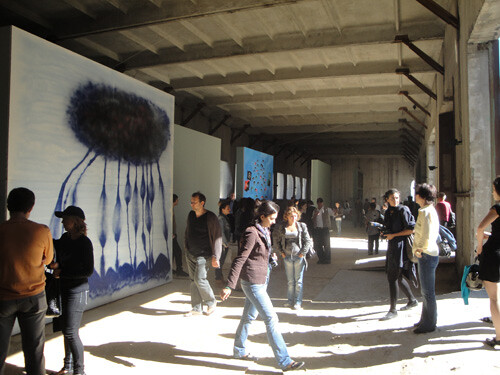

“We are helping to popularize Donetsk as a dancing tourist destination,” said Power Girl. This truly amazed me. I imagined a city in which all the tourists move about by performing ballet steps, and I even thought I misheard her. But no one in the room was surprised. (Yulya the factory director later told me that in fact everyone in Donetsk learns to dance at a young age; for girls, it is considered obligatory, and it is almost obligatory for boys.)
The moderators closed the gathering. As the panelists were already leaving, someone yelled, “Is there music planned? Should we make way for the amateurs?”
***
At the crowded dinner in the restaurant, the bureaucrat and the orange artist wanted me to sit next to them. I resigned myself to this and got ready to perform a genre I had long ago mastered—“lecture for foreigners on the peculiarities of Russian food and, more important, drink.” I would have to hold forth on the Ukrainian variation on this theme. The salt pork, pickles, and greens were already on the table, but the vodka was still on the way (they were serving horseradish vodka). After explaining what the purple leaves and long green stalks were, I refused the salt pork offered me, joking that it was against my principles to eat salt pork without vodka.
“We already heard enough about your principles at the conference today,” said the bureaucrat. “At dinner you can keep quiet.”
Wow! This was the first time my political criticism had proved so instantaneously effective. So outright deadly, so to speak. To force the Euro-bureaucrat to lose his self-control and lower himself (or raise himself?) to the level of an average Russian lout, now that was something to be proud of.
On the other hand, the conversation somehow lost its point right before my eyes. I turned my chair ninety degrees and directed my attention wholly to the ex-Czech in the orange glasses. It turned out that he had been itching to tell me a story.
It happened in the early seventies, when he was already a lucky citizen of the free Great Britain. He was flying from Japan to London. He told me why, but I didn’t catch what he said because it was clear that the juicy part was still to come. His plane was forced by bad weather to make an unscheduled stopover in Moscow at a gloomy, dark, snowbound Sheremetyevo Airport. All the passengers were led into some kind of chilly holding cage lit by a bare bulb dangling from the ceiling and made to sit on a bench.
“She just can’t be alone,” said Pavel the artist, who was sitting opposite me. He said this in 2010, not 1972. He had probably been talking about this for a long time, but I hadn’t heard what he was saying. Everything around me had somehow gotten mixed up. “She howls and howls, the poor girl. She’s a Dalmatian, very pretty. That’s why we almost never travel anywhere anymore. It’s hard to take her abroad with us, let alone to Odessa in the car. So I don’t go anywhere—I stay at home. I don’t spend time abroad, and I don’t go to exhibitions. But it’s for the best: I make paintings. She’s such a sweetie, my dog. I can’t imagine life without her.”
The KGB carefully inspected the papers of all the accidental arrivals at Sheremetyevo. The KGB was entirely of the female persuasion, dressed in pants, felt boots, earflap hats, and dark-gray uniforms. The commander was the most ferocious of the bunch. She sported a wedge cap (likewise gray) that had something red glittering on it. Somehow she had discovered that the British citizen seated before her was in fact a wretched traitor and defector from Czechoslovakia. The KGB probably knew everything. Or the woman had noticed his birthplace in his passport. Or it was simply his Czech surname. In any case, he still pronounces his “l” in the Czech manner, sweetly and moistly.
“And I have flowers,” said Pavel the artist, opposite me. “Me and the wife raise flowers. The dog took such a liking to them, it’s unbelievable.”
The wicked KGB girl did not faze the Czech. He said something contemptuous to her—in Russian, with that moist “l” of his. He probably still knew how to speak Russian back then. I did not catch exactly what it was that he had said to her. The story had taken on a life of its own and began to slosh around in my head. The orange Anglo-Czech had somehow fused in my imagination with Joseph Brodsky and begun speaking—back then, in 1972—in verse. He proudly threw back his head, smiled ironically, and handsomely wrinkled his then-unwrinkled face. The KGB girl scowled and ordered him—the Anglo-Czech or Joseph Brodsky—to leave the room with her, to walk out from under the lone light bulb and into the darkness and the unknown.
“You of course were right in your lecture today,” said Pavel the artist, who was as it were not quite addressing me. “I also often think about how unfair everything is under capitalism. We didn’t expect this. But you know, I’ve decided for myself that as an artist I’m most free when I work with a private client, however strange that sounds. Because the state, society… we have no culture in Ukraine. But aside from that I do as I please. So for the most part I’m satisfied. Yes, I’m satisfied.”
The KGB girl took the Czech to some other administrative office, also gloomy, its walls likewise painted a lettuce-green color. There was a desk in the room, leatherette chairs, and upholstered benches. Or maybe the Czech did not provide these details, and this is how I imagined the room. The KGB girl locked the door, turned towards the Czech, and with a single deft motion removed her wedge cap. Her golden hair cascaded to her shoulders (he definitely said this to me, using precisely these words, which he also accompanied with a gesture illustrating them), and she was transformed into a goddess. And then she began to make love to him.
“I’m satisfied. You know, private life is important to me now,” Pavel the artist continued in parallel with this James Bond–style fantasy. “And art is part of life, after all, not something for whose sake you have to give up something else. At any rate, that’s what I think nowadays. Like you, I also used to want to be a tribune of the people, make an impact, make someone listen to me… But not anymore.”
Rendered mushy by memories and the horseradish vodka, the Czech Brit also told me that several years afterwards, in London, he had gotten a postcard from this goddess. She had written that she remembered everything, and she had marked the postcard with a red lipstick kiss.
“It’s odd how much I like it here,” said Pavel. “And I’m not even Ukrainian at all, did you know that? Not a drop of Ukrainian blood in me. I was born in Petersburg. But I’ve put down roots here. It’s hard to explain. When perestroika began, it immediately became clear to me that nothing good would happen with a country the size of the USSR. It’s impossible to turn a big clunker like that around. But it’s a different story with Ukraine. The scale here is smaller, there’s less of everything. There’s some kind of hope here. And what if suddenly something does work out?”
Flocks of cherry-filled dumplings had already begun flying out from the sleeves of the waiters sliding past our tables. The dinner was winding up. I headed to the next table, where my old friends Borya and Vita Mikhailov were sitting. Borya told me that he was certain that the Donetsk initiative would make a go of it. He said that Lyuba Mikhailova does not do anything just like that, which meant that she needed this project for some reason.
Lyuba came up to me right then. We had a drink and switched to using the informal “thou” form. She told me she didn’t know why she needed to do this project. It was just that she had already done many things in her life, and she had been to the Venice Biennale many times and liked it there. And there is Pinchuk, but is he really the only patron of the arts in Ukraine? Her girlfriends ask her to sell them paintings to decorate their houses, and she could do that; only that’s not what she had in mind. What she wants is for people to hear about Donetsk. And she could make a deal with the local authorities about anything whatsoever, but she sees no point in doing this. She doesn’t want to deal with any state institutions. What she wants is something that belongs to her, something privately run, a place where no one can tell her what she can and cannot do and whether she can do anything at all, and whom she can invite.
“He got it right,” she said, recalling the Euro-bureaucrat. “When you invite people, you invite them along with their problems.”
After the cherry dumplings had been served, stout, meaty cabbage rolls also landed on our table for some reason. I had already made my peace with everything under the sun, including my defeat in the battle against neoliberalism in the land of Donetsk, where everything private still seems more encouraging, hospitable, and plain-old delicious than anything having to do with the public sphere and, all the more so, with the state. Where planning of whatever sort is still seen as a heavy chain, and the principal value is freedom. It is just that some people have the opportunity to interpret this term economically, while for others it remains a lovely spiritual metaphor.
“I wanted to support you,” a young woman seated opposite me said suddenly with unexpected vehemence. “Nobody here understood anything, but I know what you were talking about. I study in London. I have big problems there because I read Negri: they’re not letting me write the kind of dissertation I want to write. I see how capital strangles people. I see the injustice. I see how the law is directed against the weak. I see how people are exploited and how all this is covered up by the terrible neoliberal lie. I just wanted to tell you I understand what you were talking about.”
I was quite surprised, because no one is persecuted for holding leftist views in the art world in the West, insofar as they are the norm there, but it turned out that the young woman was in law school. It also turned out that she was Lyuba’s daughter.
The last person I spoke with that evening was the architect from London who designed the reconstruction of the factory. The project is quite considerate: in the sketches, the building, which looks almost the same, only slightly improved, is surrounded by crowds of people enjoying themselves—despite the fact that the factory is far from downtown by Donetsk standards, a half-hour’s bus ride away, and the bus does not come often.
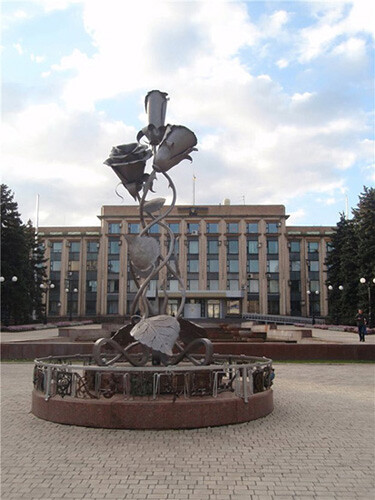

The architect looked somewhat lost. He had been given the chance to realize a prestigious large-scale commission, and I suspect that he was well paid and lavished with respect. But he was clearly ill at ease.
“One building is not enough, right?” he asked himself. “One building won’t change anything here. You have to create infrastructure, you have to open up to the community. You have to make it so that people come here and so that there is something for them to do here. There are so many things that have to be changed, and this is an enormous responsibility… I don’t know whether they understand this or not.”
The evening was coming to an end. A fireworks salute in the shape of a blazing rose shot up on the horizon over the dead silhouettes of five-story apartment blocks. It was followed by another, then by an inexhaustible bouquet of these gigantic Donetsk roses. I thought it must have been some kind of Ukrainian state holiday I had never heard of, but I was told that it was more likely one of the Donetsk mobsters celebrating his girlfriend’s birthday.
Translated from the Russian by Thomas Campbell
